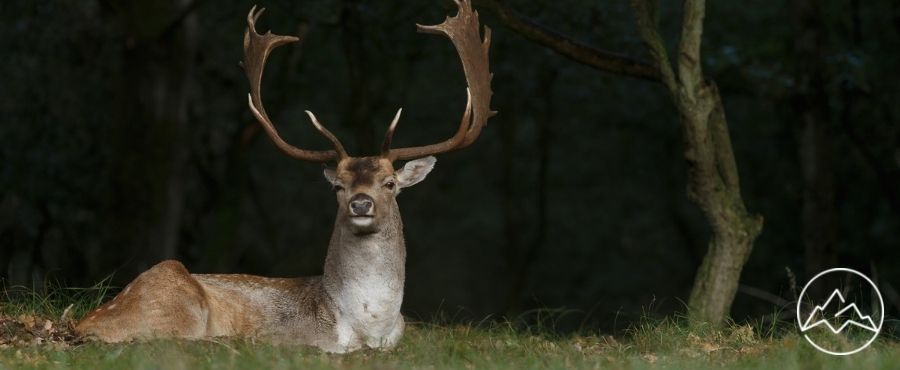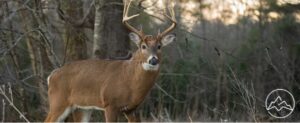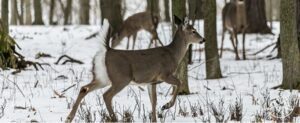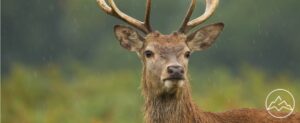When you’re deer hunting, irrespective of how careful you are or the method you choose to hunt (firearm or bow), you’ll likely have a bad shot one day. Hunting can be unpredictable. If a deer darts or an unseen branch interferes with your arrow, you could injure your catch rather than kill it outright. We all strive to be better, and if you’re as ethical as most hunters are, it’s devastating when you’re confronted with a deer’s blood trail. It’s common to feel guilty and disappointed. But you should remain calm and resolve to find the deer. To do so, you’ll need to track it. Tracking wounded deer is an acquired skill that all hunters should have. Skilled trackers always do their best during whitetail season.
Step 1: The deer
The first thing to consider is the deer. Which direction did it run in? How did it react when you fired? It’s not a guarantee, but you may pick up some information that can help you later. You should always try for a follow-up shot if you get a chance. There are a few clues you should note, though.
- If you’re bowhunting and the deer kicks its hind legs while jumping slightly, it could mean you’ve hit the vitals. Deers hit with firearms won’t usually react this way. Instead, they sprint off, keeping low to the ground. A deer that mule kicks like this usually dies within around 100 yards.
- If a deer curls up slightly, lowers its head, and runs off while hunched over, you may have hit it further back, in the guts or liver.
- You’ve probably missed if the deer runs off with its head held high.
Make a note of exactly where the deer was when you fired and the last place you saw the deer before it was out of sight. Most deer will bed down within a few hundred yards. Most will die while bedded down.
Step 2: Relax
It may sound ridiculous, but the best thing to do may be to take a break. If you get down from your tree stand and start trailing the deer, you may push it from its first bed. Usually, a clot will plug any injuries temporarily and slow the blood trail, which is a terrible situation to be in. Sit down, reflect on what happened, tend to your hunting gear, and have a snack if possible.
In the best-case scenario, a shot in the vitals is the fastest. You should wait at least 20 minutes before you get down and track the deer. You should check your watch immediately to know when the deer was lost. If you’re pretty sure that the shot didn’t hit the lungs or heart, wait a few hours. Either remain in your stand or slip out and come back later. If you chase a deer further away, it can make it even harder. They’ll usually die within a few hundred yards if you give them time.
Step 3: Investigate the scene
After the time has lapsed, subtly check the ground where you shot the deer for any signs. Common signs include deeper deer tracks, overturned leaves, broken branches, or blood. Mark the spot with some tape or toilet paper if you can.
If you find hairs or blood, this is an excellent sign.
- Red/pinkish blood with bubbles indicates a vital shot to the lungs. If you’ve waited 20 minutes, this is plenty. Lung shots can also be combined with heart shots.
- A few dark hairs indicate a body shot which could be a good sign.
- Bright red blood spray indicates a heart shot – this is the best-case scenario. The animal will almost certainly die within a minute.
- Lots of blood can indicate that you’ve hit a major artery – it’ll die within a short distance.
- A dark red/maroon stain could indicate a liver shot.
- Brown/yellow with an odor can indicate you’ve shot the deer somewhere in the digestive system, a gut shot. It will still die, most likely from septic shock, but it can take longer.
- Long white hairs indicate a non-vital shot.
Despite this, there are still notable cases where the deer will die even without leaving much of a blood trail. Signs of broken branches and other tracks can still lead you to the deer. This is especially true if you hunt with a rifle and the bullet doesn’t exit the body. The wound can be small, while the internal injuries are fatal.
Hunting with a bow gives you more clues as to the blood on the arrow (assuming it exited the deer) and can help you identify where you hit the deer.
Step 4: Proceed slowly
You should proceed with caution; it’s easy to miss vital clues. You may even accidentally bump into the deer and scare it from its bed, which decreases your chances of finding it. You should often stop to scan ahead with your scope or binoculars. If you need to return and re-inspect the trail, you should avoid walking directly on the trail. Deer are unpredictable but re-examining the trail may prove fruitful. You can’t do that if you’ve destroyed the trail. Once the trail ends, scan the area carefully. Scan for overturned leaves, broken branches, or even a drop of blood. Anything to keep you moving forward.If you don’t, an excellent method is marking the area with a hat, toilet paper, etc., to show your last known sign or blood trail. Slowly circle the area, increasing the circumference each time. You’ll usually find another clue.
Step 5: Luck
If the above doesn’t work, the last thing you can try is just luck. Call up a friend and see if anyone is available to help you do a grid search. Head to the last sign of track and spread out every few yards. Move forward, slowly scanning everything.
Tracking dogs are a great asset, but they’re not always legal. Pay attention to the sound of ravens or crows cawing, too. Coyotes calling could also indicate that they found the kill before you did. Even if it were an imperfect shot, you’d usually find the deer. It’s a great sense of relief when you do. Be careful not to rush when you see your deer if it tries to get up again. Slowly move forward and try to touch the deer, but keep your weapon ready.
You’ll eventually need to call the search off if you don’t find it. It’s not a decision I’ve made too many times, but it’s always devastating. Try not to be too hard on yourself, though. Try to figure out what went wrong and avoid that happening again.
FAQs About Tracking a Wounded Deer
What methods are available to track a wounded deer?
How can hunters determine the best route to take when tracking a wounded deer?
What type of equipment is necessary for tracking a wounded deer effectively?
Is there any advice that experienced hunters can provide on tracking wounded deer?
Can technology such as GPS devices be used to help track injured animals, including deer?
Conclusion
If you start tracking immediately, you have a good chance of finding your deer. A follow-up shot is the most ethical thing a deer hunter can do, but the trail can be a close second following the deer.Whether or not you find the deer, you’ll inevitably consider what went wrong. You should pay proper attention to scent control and camouflage to avoid it happening again. Still, it’s something that happens to the best of us. Hunting skills aren’t instantaneous, and tracking skills aren’t either; you’ll learn with time.











